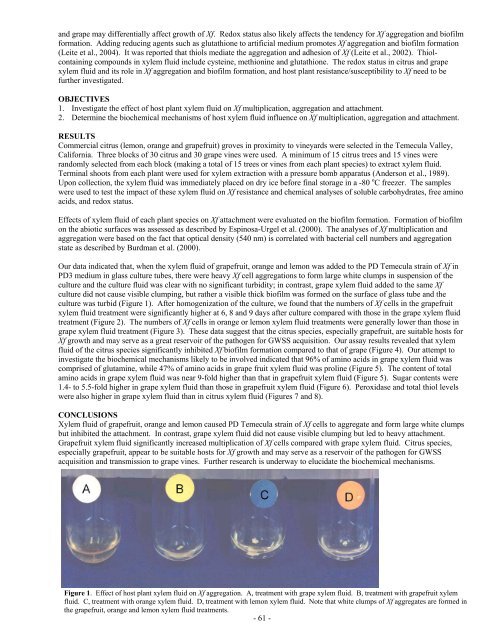Impact Of Host Plant Xylem Fluid On Xylella Fastidiosa Multiplication ...
Impact Of Host Plant Xylem Fluid On Xylella Fastidiosa Multiplication ...
Impact Of Host Plant Xylem Fluid On Xylella Fastidiosa Multiplication ...
Create successful ePaper yourself
Turn your PDF publications into a flip-book with our unique Google optimized e-Paper software.
and grape may differentially affect growth of Xf. Redox status also likely affects the tendency for Xf aggregation and biofilm<br />
formation. Adding reducing agents such as glutathione to artificial medium promotes Xf aggregation and biofilm formation<br />
(Leite et al., 2004). It was reported that thiols mediate the aggregation and adhesion of Xf (Leite et al., 2002). Thiolcontaining<br />
compounds in xylem fluid include cysteine, methionine and glutathione. The redox status in citrus and grape<br />
xylem fluid and its role in Xf aggregation and biofilm formation, and host plant resistance/susceptibility to Xf need to be<br />
further investigated.<br />
OBJECTIVES<br />
1. Investigate the effect of host plant xylem fluid on Xf multiplication, aggregation and attachment.<br />
2. Determine the biochemical mechanisms of host xylem fluid influence on Xf multiplication, aggregation and attachment.<br />
RESULTS<br />
Commercial citrus (lemon, orange and grapefruit) groves in proximity to vineyards were selected in the Temecula Valley,<br />
California. Three blocks of 30 citrus and 30 grape vines were used. A minimum of 15 citrus trees and 15 vines were<br />
randomly selected from each block (making a total of 15 trees or vines from each plant species) to extract xylem fluid.<br />
Terminal shoots from each plant were used for xylem extraction with a pressure bomb apparatus (Anderson et al., 1989).<br />
Upon collection, the xylem fluid was immediately placed on dry ice before final storage in a -80 o C freezer. The samples<br />
were used to test the impact of these xylem fluid on Xf resistance and chemical analyses of soluble carbohydrates, free amino<br />
acids, and redox status.<br />
Effects of xylem fluid of each plant species on Xf attachment were evaluated on the biofilm formation. Formation of biofilm<br />
on the abiotic surfaces was assessed as described by Espinosa-Urgel et al. (2000). The analyses of Xf multiplication and<br />
aggregation were based on the fact that optical density (540 nm) is correlated with bacterial cell numbers and aggregation<br />
state as described by Burdman et al. (2000).<br />
Our data indicated that, when the xylem fluid of grapefruit, orange and lemon was added to the PD Temecula strain of Xf in<br />
PD3 medium in glass culture tubes, there were heavy Xf cell aggregations to form large white clumps in suspension of the<br />
culture and the culture fluid was clear with no significant turbidity; in contrast, grape xylem fluid added to the same Xf<br />
culture did not cause visible clumping, but rather a visible thick biofilm was formed on the surface of glass tube and the<br />
culture was turbid (Figure 1). After homogenization of the culture, we found that the numbers of Xf cells in the grapefruit<br />
xylem fluid treatment were significantly higher at 6, 8 and 9 days after culture compared with those in the grape xylem fluid<br />
treatment (Figure 2). The numbers of Xf cells in orange or lemon xylem fluid treatments were generally lower than those in<br />
grape xylem fluid treatment (Figure 3). These data suggest that the citrus species, especially grapefruit, are suitable hosts for<br />
Xf growth and may serve as a great reservoir of the pathogen for GWSS acquisition. Our assay results revealed that xylem<br />
fluid of the citrus species significantly inhibited Xf biofilm formation compared to that of grape (Figure 4). Our attempt to<br />
investigate the biochemical mechanisms likely to be involved indicated that 96% of amino acids in grape xylem fluid was<br />
comprised of glutamine, while 47% of amino acids in grape fruit xylem fluid was proline (Figure 5). The content of total<br />
amino acids in grape xylem fluid was near 9-fold higher than that in grapefruit xylem fluid (Figure 5). Sugar contents were<br />
1.4- to 5.5-fold higher in grape xylem fluid than those in grapefruit xylem fluid (Figure 6). Peroxidase and total thiol levels<br />
were also higher in grape xylem fluid than in citrus xylem fluid (Figures 7 and 8).<br />
CONCLUSIONS<br />
<strong>Xylem</strong> fluid of grapefruit, orange and lemon caused PD Temecula strain of Xf cells to aggregate and form large white clumps<br />
but inhibited the attachment. In contrast, grape xylem fluid did not cause visible clumping but led to heavy attachment.<br />
Grapefruit xylem fluid significantly increased multiplication of Xf cells compared with grape xylem fluid. Citrus species,<br />
especially grapefruit, appear to be suitable hosts for Xf growth and may serve as a reservoir of the pathogen for GWSS<br />
acquisition and transmission to grape vines. Further research is underway to elucidate the biochemical mechanisms.<br />
Figure 1. Effect of host plant xylem fluid on Xf aggregation. A, treatment with grape xylem fluid. B, treatment with grapefruit xylem<br />
fluid. C, treatment with orange xylem fluid. D, treatment with lemon xylem fluid. Note that white clumps of Xf aggregates are formed in<br />
the grapefruit, orange and lemon xylem fluid treatments.<br />
- 61 -











